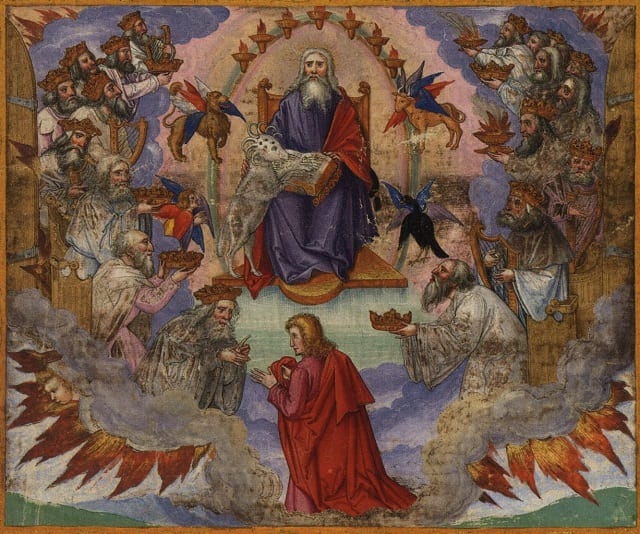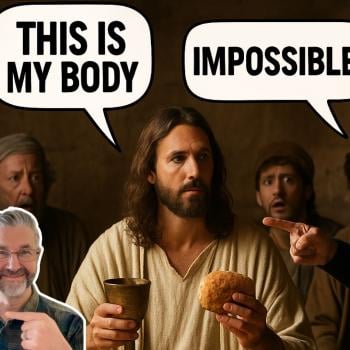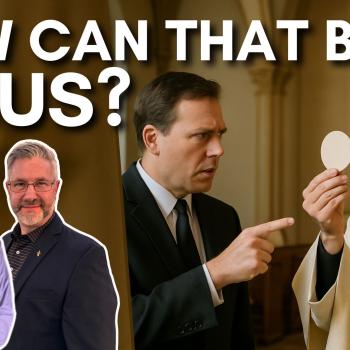
1. Every Catholic has a canonical right to receive Holy Communion kneeling, and on the tongue. If they are denied this right, they should appeal to the bishop, and if needs be to the pope. It can’t change unless canon law changes.
2. Therefore, to call anyone a schismatic simply because this is what they prefer (I did this myself in my traditional parish for 25 years) is an outrage. And it’s almost as bad — short of that error and sin — to disparage someone because of the way they choose to receive Our Lord at Mass.
So far I enthusiastically agree. Now where I respectfully disagree:
3. It’s equally wrong to say that receiving kneeling on the tongue is automatically, unquestionably (in every case) “more humble and reverent.” And it’s equally wrong and unsustainable to believe the converse: everyone who receives in the hand, standing is intrinsically or inherently less reverent and humble. These things simply can’t be determined merely by the mode of Holy Communion. They are interior; matters of the heart and spirit.
4. If such a person makes you an “enemy” they are dead wrong; I agree. But if they simply argue as I have just done in #3, they can’t be accused of not believing in the Real Presence. This further contention wasn’t made above; I strongly urge traditionalists to not go down that road. Both methods are allowed in the Church (just as two forms of the Latin Rite Mass are). Until they are not, we can’t make these [blanket / uniform] judgments either way, and should worship and let worship.
The common ground here is that we can all vigorously, zealously oppose irreverence and disbelief in the eucharistic Real Presence, while avoiding the legalism that occurs on both sides of the question. We can all oppose clear liturgical abuses and violations of the rubrics of the Mass.
They are interior; matters of the heart and spirit.
Are you saying then that certain exterior postures have no intrinsic reference to being humble or reverent such that it makes no difference to one’s external posture for the interior things?
Because it seems like you’ve transferred the question, unnecessarily, to the interior alone as if the exterior makes no difference. While the claim is precisely about the exterior posture. And Dan Burke and others would no doubt say, of course an individual could receive it more humbly (i.e. with reference to their interior disposition) in a different posture (saying standing rather than kneeling) despite that posture. So in some ways it seems like in #3 you are not addressing the point at issue.
The question is whether kneeling, receiving on the tongue is in itself a more reverent posture than the alternative and whether one or the other posture better disposes one to receive the Eucharist (though it’s not simply a matter of better disposing to reception) even if, again, one may be following the best postures and yet not be as disposed to receiving the Eucharist well as one who does not follow those postures.
Hi Matthew. Thanks for your questions. I appreciate it because they have drawn from me some new arguments that I haven’t used before on this issue.
Revelation 8:2-4 (RSV) Then I saw the seven angels who stand before God, and seven trumpets were given to them. [3] And another angel came and stood at the altar with a golden censer; and he was given much incense to mingle with the prayers of all the saints upon the golden altar before the throne; [4] and the smoke of the incense rose with the prayers of the saints from the hand of the angel before God.
Revelation 7:9-12 After this I looked, and behold, a great multitude which no man could number, from every nation, from all tribes and peoples and tongues, standing before the throne and before the Lamb, clothed in white robes, with palm branches in their hands, [10] and crying out with a loud voice, “Salvation belongs to our God who sits upon the throne, and to the Lamb!” [11] And all the angels stood round the throne and round the elders and the four living creatures, and they fell on their faces before the throne and worshiped God, [12] saying, “Amen! Blessing and glory and wisdom and thanksgiving and honor and power and might be to our God for ever and ever! Amen.”
Revelation 5:8-10, 14 And when he had taken the scroll, the four living creatures and the twenty-four elders fell down before the Lamb, each holding a harp, and with golden bowls full of incense, which are the prayers of the saints; [9] and they sang a new song, saying, “Worthy art thou to take the scroll and to open its seals, for thou wast slain and by thy blood didst ransom men for God from every tribe and tongue and people and nation, [10] and hast made them a kingdom and priests to our God, and they shall reign on earth.” . . . [14] And the four living creatures said, “Amen!” and the elders fell down and worshiped.
Revelation 11:16 And the twenty-four elders who sit on their thrones before God fell on their faces and worshiped God,*Revelation 19:4 And the twenty-four elders and the four living creatures fell down and worshiped God who is seated on the throne, saying, “Amen. Hallelujah!”
My own opinion is that, in our culture at this time, kneeling for communion does foster reverence (including in children). I love doing it at my church. It is a wonderful time, waiting at the rail, taking in the beauty of the altar at my church. But I can’t make any kind of universal statement as to receiving standing. The whole thing is too specific to person and culture and particular liturgical traditions, I think. . . . I think reverence does differ to some extent according to culture and past history. That’s why I agreed that kneeling is probably best in the west, while trying to avoid legalistic and judgmental statements about other practices. (7-13-11)
One can argue cultures and situations. I agree that kneeling is generally regarded as more reverent in America, at least; I even agree (i.e., in my particular culture, at this time and place) that it is more conducive to reverence in the Mass . . . (1-23-13)Encouraging communion on the tongue as a preference or recommendation is one thing, and I have no problem with that. What I have a problem with (and what I would say is contrary to the Mind of the Church) is when people get legalistic and claim that those who do it the other way (in the hand) are / must be liberals or modernists or bad Catholics or “neo-Catholics.” The latter is radical Catholic reactionary thinking or close to it; the former is simply a preference for traditional liturgy. (6-20-13)I argue for preference in this time and place and culture (kneeling / on the tongue, from the priest), but I don’t argue for intrinsic superiority of same. And the early Church’s practice is a major reason why I don’t. It’s a classic case of where being aware of history has a real and important impact on a particular debate. (7-8-13)I think in practice communion in the hand often is irreverent, but again, I think that has to be analyzed within the overall context of a “spirit” among many Catholics of lack of reverence and understanding of transubstantiation, in their hearts. It’s a matter of origins. In this thinking, communion in the hand is not the initial cause of lack of reverence, but rather, prior factors of nonbelief or “non-appreciation” of the Holy Eucharist, already residing in the heart. (9-4-15)So you have a particularly consecrated, holy tongue? According to Holy Scripture (many passages), you’re more likely to have a wicked tongue than hands. You are “handling” him on your tongue. How is a tongue different from a hand? They’re both part of sinners like you and I. That’s not the proper distinction. It’s between the pious, reverent person and the one who isn’t. And either disposition can happen in either method because it is a heart and soul issue, not a physical one.An atheist or Satanist could receive on the tongue and keep the consecrated host (i.e., Jesus) for Satanic Masses, or contemptuously spit Him out.We can receive on the hand because the Church allows us to, and because it was the main way to receive in the early Church. I agree that the priest has consecrated hands (and beyond that, is the alter Christus), which is why I do my utmost to try to receive from a priest if it is at all possible (and I’ve written about habitual improper overuse of eucharistic ministers, contrary to the rubrics). (3-14-20)
I’m not quite sure that these two ideas can be reconciled:
(1) “It’s my own preference.”
(2) There is something intrinsic to certain postures that make them the kind of thing one does when one wants to be humble and reverent.
So I do think there are different traditions (East and West) within this and it is helpful to think within the Latin/Western tradition for us.
Exactly! Your (1) and (2) cannot be reconciled. This is the heart of my argument. Along with you guys, I myself make the argument from (1). I do not contend for (2) because it is inconsistent with (1). But y’all (usually traditionalists and/or reactionaries) do that.
There are lots of illogical points of view out there; this is one. It’s based purely on emotion and subjectivism. It is indeed based on cultural preference, and that’s fine, as long as it’s understood as relative, as opposed to objective (one thing for all).
“receiving in the hand, standing was prevalent for much of the first thousand years in the Church”
I’d be happy to see some sources for this claim – maybe I missed those as I read through your long posts. If memory serves, this is a typical argument used for today’s practice that has been later been found to rest of bad historical scholarship (but I’d have to track down those articles myself) – and I think at best the claim was something like it was done in the very early Church. At any rate, I think that’s probably false that Christians have received in the hand for 1000 years – and that it is even common among traditions then to not receive in the hand.
*
St. Augustine’s Holy Communion (Standing, in the Hand) [10-4-15]
Communion in the Hand: Reactionaries vs. St. Cyril [3-15-20]
I also don’t find it very convincing that standing in heaven worshiping God shows that standing in itself is as reverent as kneeling. It could mean a couple of things. One it could be a result of our glorified bodies and so unable to be compared at all to us without glorified bodies. Two it could mean that standing is sufficiently reverent for the event of worshiping- just like one may sit during adoration e.g. – which is quite distinct from receiving God in the Eucharist.
Your argument from glorified bodies is very interesting, but I think it fails once we take all the scriptural data into account. You say that standing may somehow be some sort of requirement of having a glorified body. A man with a glorified body can’t kneel? I don’t see how that follows.
In any event, the texts I’ve already provided shows glorified human beings in heaven worshiping God standing (Rev 7:9-10), and prostrated (Rev 5:8, 14; 11:16; 19:4), but not kneeling. If they can lie prostrate, then they can kneel.
Surely, this has some significance. It can’t be dismissed as of no relevance. I’m quite sure that if kneeling was featured in Revelation (especially if exclusive), that would be trotted out as a proof text for your view. As it is, it’s not there at all. I never knew that till I studied it today, Now I know. The Bible never fails to teach us.
The angel text is not relevant for they do not have bodies. So whatever “standing” means there it ought not to be taken as an indication of the propriety of standing.
Your argument from the angels not having bodies is more fun. You are correct, of course, but you have to explain why Revelation still describes them as prostrate in addition to standing (Rev 7:11-12).
Other passages attribute to them physical features, which must be in an anthropomorphic (similar to how God is often described) or metaphorical sense; for example, they are described as sitting (Jud 6:11; Mt 28:2). The Angel of the Lord wrestled with Jacob (Gen 32:24-25, 30). Angels are described as eating fish (Tob 6:5), and as having a hand (Num 22:23, 31; 1 Chr 21:16; Rev 10:10).
Therefore, angels are described in all sorts of ostensibly “physical” ways (and there are theophanies as well), which shows that they could also be described in the same non-literal sense (however it is construed) as kneeling. Again, if they can sit and lie prostrate, they can kneel (i.e., in this non-literal sense). As it is, they are described in Revelation as worshiping God in both standing and prostrate positions.
This does not help your case at all. It supports mine.
Okay, then I’m not sure what you mean by this: “I’m not denying any connection whatsoever; only intrinsic or necessary connection, and sweeping statements.” What connection is there?
You misunderstood my objection to the man standing in heaven. I didn’t say they could not kneel; only that the situation may be different enough not to apply to what you are trying to apply it to.
You are making many leaps here. Just because these passages may have “some” significance, doesn’t mean they have the significance that you give it.
Of course angels have been described in physical ways. But how is that relevant? Why does it mean that one can simply conclude to something about what angels – who don’t have bodies – are described bodily to what humans do? You just assert your conclusion but you leave out the middle steps – perhaps thinking it is obvious.
“There are lots of illogical points of view out there; this is one. It’s based purely on emotion and subjectivism.”
You don’t think there is any objective evidence or rational arguments given for a particular posture being more humble/reverent? That seems, at the very least, just a little overstated.
The connection is that we may feel that kneeling is more reverent in our particular culture and time (as many of us, including myself, do).
But why would anyone feel this connection if it is not objective in any way?
That’s a real connection and a real thing, but it is subjective and not objective, and the Bible and the history of the Church shows us that it is not the be-all and end-all, and is relative over time and place (and standing continues to be the norm in Eastern Catholicism, etc.).
The Bible does not appear to consider any posture more reverent than another, and refers to kneeling, prostration, and standing as all related to worshipful postures.
But we are not talking about postures of worship. No one argues against standing at mass for example. We are talking about postures in receiving the Eucharist. Those are distinct things.
It would have been perfectly biblical if the Church had followed the more prevalent models in Scripture of prostration and required that prior to Holy Communion (just as it is part of the ordination of priests).
But I found it interesting that the book of Revelation doesn’t mention kneeling.
Why?
Other places in the Bible do, as I have myself documented in a paper.
I think the rest of your comments descend into more and more obscure aspects, and I think they miss the forest for the trees (which I have a distaste for because the discussion then gets more and more distant from its essence), so I’ll let you have the last word.
Giving a bunch of bad arguments doesn’t equate to a good argument. And as I keep pushing on your arguments/evidence. It doesn’t stand up upon closer scrutiny. In the end, the bunch of trees you are trying to collect, so to speak, doesn’t add up to a forest. It’s more barren in fact.
You haven’t shown me any unanswerable biblical evidence that kneeling is the most reverent position, let alone supposedly the only one anyone should do when receiving Holy Communion.
I actually haven’t given an argument for anything. I’ve just asked questions of you that you are unable to answer in a consistent way. And have pointed out many leaps in your logic. Maybe your conclusions are right, but your arguments don’t anywhere near prove them.












